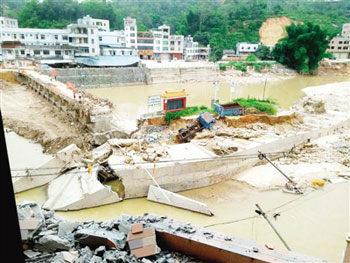Why did Xinyi suffer from the flooded El Nino?
Original title: 540000 people are affected by disasters once in 200 years.
Why Guangdong Xinyi has become a "rainy nest"

On May 23, floodwaters receded in Xinyi City, Maoming, Guangdong Province, leaving behind bridges destroyed by floods and mountain village buildings knocked down by mountain torrents and landslides. Photo taken by Sun Jiuwan
On the evening of May 20, the reporter drove back to Guangzhou from Zhanjiang. At first, there was a patter of light rain on the highway, but then it was raining more and more heavily, and when it passed through the section of Maoming, it was already raining heavily, and the car window was like a water curtain.
Only later did we know that we had caught the extremely heavy rainfall that we had once in 200 years. When the reporter arrived in Guangzhou in the early morning, there was almost no rain in Guangzhou. The next day, I learned that a round of local torrential rain occurred successively in Maoming from north to south that day, among which there was an extremely heavy rainstorm in Xinyi City and Beijie Town. 00:00 on the 20th to 14:00 on the 20th, Xinyi City and its Beijie Town, Jinxing Town, Chi Dong Town and other places recorded rainfall of more than 240mm, and the rainfall in Dingbao Town, Xinyi City was as high as 298.2 mm.
The reporter only experienced the "wet apricot blossom rain" in Zhanjiang City, which borders Maoming on the 19th, where he expected that only a hundred kilometers away, there would be torrential rain and wanton winds. In Xinyi City, Maoming, a total of 540000 people were affected by the disaster, with 8 dead and 4 missing, with direct economic losses of more than 500 million yuan. The reporter learned in an interview in Xinyi that in this disaster, Xinyi City dispatched a total of 15 assault boats to transfer 51420 people.
On May 23, when the interviewer of Science and Technology Daily arrived again in Xinyi City, Maoming, the sun was shining high again. The flood receded, and the reporter's camera left only the bridges washed out by the flood and the mountain village buildings knocked down by mountain torrents and landslides.
According to the staff of the local meteorological department, the main causes of the severe flooding in Xinyi are the special geographical location and the rare extremely heavy rainfall. As Xinyi is located in the high mountains of Yunkai Mountains, one of the three major mountains in Guangdong, it is the center of rainstorm in Guangdong. Under the attack of heavy rainfall, mountain torrents that can easily lead to sharp ups and downs, especially in Xinyi urban area, are surrounded by mountains. Under the continuous attack of 6-hour rainfall exceeding double extremes and heavy rainfall once in 200 years, the surrounding floods are concentrated in the urban area, resulting in serious waterlogging and serious disasters.
The interviewer sent by the Science and Technology Daily went directly to Beijie Town of Xinyi City, which was the worst of the extremely heavy rainfall natural disasters. Although the rainstorm has passed, the town has been devastated by torrential rains and mountain torrents, and 35 villages (dwellings) in the town have been affected to varying degrees. Among them, Liangyi, Luohan, Liuyun, Changwangli, Beijie and other villages are more serious.
As of 20:00 on May 21, the affected population of the town was more than 88000; the affected area of crops was 15700 mu, and 21169 livestock and poultry were washed away and missing (head); 278 houses collapsed, of which 20 households collapsed; 92 roads were interrupted and 11032 meters of roads were damaged; 24 bridges were damaged; 967 landslides; 25590 meters of embankments were damaged, 4228 meters of dike breaches, 221 slopes and 448 irrigation facilities were damaged. Five hydropower stations were damaged, all power communications were interrupted, and the direct economic loss was more than 23 million yuan.
Changwang bridge is the main channel connecting Changwang village and town. Since its construction in 1984, although it has been reinforced twice, it can be cut off in this extremely heavy rainfall natural disaster. The houses of the two brothers Pan Qingwei and Pan Qingquan, who are close to the bridgehead, have been destroyed. At present, more than 10 members of the brothers' family have set up two tents to live in an abandoned chicken farm. The two brothers have been worried about how long it will be like this.
A reporter from the Science and Technology Daily specially interviewed the Climate Center of Guangdong Province and learned that it was all caused by El Nino. Cheng Zhengquan, chief forecaster of Guangdong Meteorological Observatory, said that in terms of spatial distribution, the heavy precipitation showed the characteristics of "two rain belts in the north and one rain nest in the west." the rainstorm belt in the north is located in the area of Shaoguan-Qingyuan-Zhaoqing, the rainstorm belt in the south is located in the coastal area between Shanwei and Yangjiang, and there is a rain nest of local torrential rain in Xinyi area of Maoming.
Experts at the center said that although the super-strong El Ni ñ o event is expected to end in May, its impact will continue, and the probability of extreme weather in Guangdong Province in the future is still high.
Wu Hongyu, chief expert of the Guangdong Climate Center, said that under the influence of the super-strong El Nino event, the climate of Guangdong Province has been obviously abnormal since the beginning of this year, showing three major characteristics: "significantly more precipitation, early flood anomalies, and frequent severe convective weather."
El Ni ñ o mainly refers to the abnormal continuous warming of sea water temperature in the tropical oceans in the eastern and central Pacific Ocean. La Nina is the opposite of El Ni ñ o. La Nina refers to the phenomenon that the sea surface temperature continues to be unusually cold in the eastern and central equatorial Pacific. After the occurrence of extremely strong El Ni ñ o phenomenon, it is more likely to turn to La Nina phenomenon.
The reporter learned from the Guangdong Provincial General Administration of Prevention that the La Nina phenomenon may appear in July after the end of the El Nino incident. As the climatic background of this year is similar to that of 1998, the probability of regional flood in Guangdong has increased. The Xijiang and Beijiang rivers may have a flood once in 10 to 20 years, and some small watersheds in Shaoguan and Qingyuan may have a severe flood in 50 years, accompanied by serious local urban waterlogging and mountain torrents.
The meteorological department has suggested that under the alternating influence of super El Ni ñ o and La Nina phenomena, there is a high probability of extreme weather such as rainstorm, flood, high temperature and drought. In addition, tropical cyclones that make landfall in southern China this year may also have the characteristics of a small number and strong intensity. Mainly before the flood and after the drought, the first flood season precipitation will be more, the later flood season precipitation will be less, this stage is very obvious. Therefore, there is a lot of precipitation in the early stage, we should pay attention to prevent landslides, debris flows, geological disasters and strong convective weather. In the latter part of the flood season, we should pay attention to drought prevention.
At the disaster relief site in Xinyi, the reporter saw that disaster relief workers pressed ahead with the clean-up work against the scorching sun. Dozens of excavators have been started in Beijie Town and Jinchuan Town of the worst-hit town to carry out post-disaster recovery work.
"El Nino" is gone, I do not know when "La Nina" will arrive unexpectedly. Since it is unstoppable, we have to do enough work on disaster prevention as soon as possible to minimize the losses of future disasters. (correspondent Sun Jiuwan Qian Congbo, our reporter Zuo Chaosheng Science and Technology Daily, Guangzhou, May 23rd)
Related
- A course of planting techniques and methods on how to grow carrots
- How to plant the latest tulips?
- Is it better to pick tea in the morning or in the afternoon? When is the best time for tea to be picked? what is the third or fifth tea?
- Launch Yuanxiao Happy combination Haocha + Tea Yuan healthy Taste
- Penghu Tourism "Fireworks 20 Parade with You"
- 2022 West Lake Happiness holds "Digital Revitalization Voucher" and draws iphone13 and laptop.
- Banqiao Fuzhou social houses are designed to change start-up combined with police elimination to create a safe and livable environment
- The convenient measure of "mechanical weeding" in Xinbei has been abused and the Agriculture Bureau has imposed heavy penalties on the illegal land consolidation.
- Changgeng University Joins Hands with Four Memory Factories to Rescue Memory Talent Shortage
- The list of Taiwan's top 100 MVP managers is listed by the Director-General of the Farmers' Association of Sanxia District.



